


Evolution refers to something gradually developing and making changes over long periods of time. In science, evolution (or, more specifically, the Theory of Evolution) refers to how organisms change over time (typically millions of years) as a result of inherited adaptations that make it easier to survive, depending on where they live.
Evolution happens as the result of a process called Natural Selection.
Natural Selection happens because of the basic fact that all organisms within a species have random differences, or mutations, between them. A good example of a random mutation in humans is how we all have different-sized ears and noses.
The picture below shows an example of a random mutation. Notice how all four of these platypuses have different-sized tails.
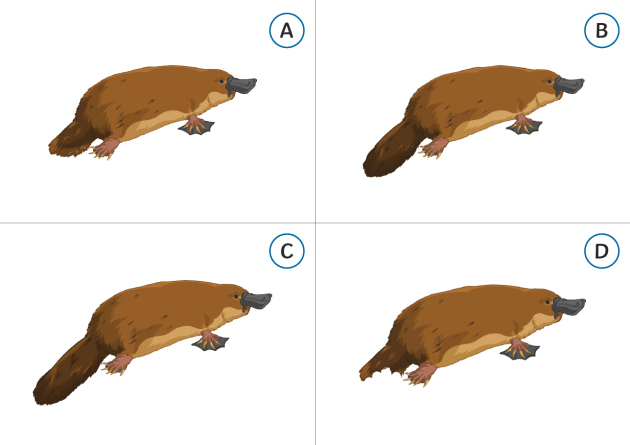
Often these mutations are ineffective, in that they have no effect, good or bad, on that member of a species. Humans having different-sized noses, for instance, doesn’t appear to make us any better or worse at smelling things.
But sometimes, a random mutation makes it easier or harder for that organism to survive than others in its species. For instance, a longer neck might make it easier to reach for leaves on high trees to eat, or a poorer sense of smell might make it harder to detect whether edible-looking plants are poisonous.
This is important in nature when there often aren’t enough basic resources (food, shelter, warmth) for every living creature to survive. In these instances, only the organisms with those beneficial mutations will live for long enough to reproduce. They will pass that mutation onto their offspring, and so it will continue until that mutation goes from being random to being a noticeable change within the species.
When enough of these changes happen, the species is said to have either evolved into another species or to have branched out into a number of different species.
The image below is a very simplified version of an evolutionary tree. See how the one animal at the bottom is shown to have branched out and eventually become all sorts of different animals, including humans?
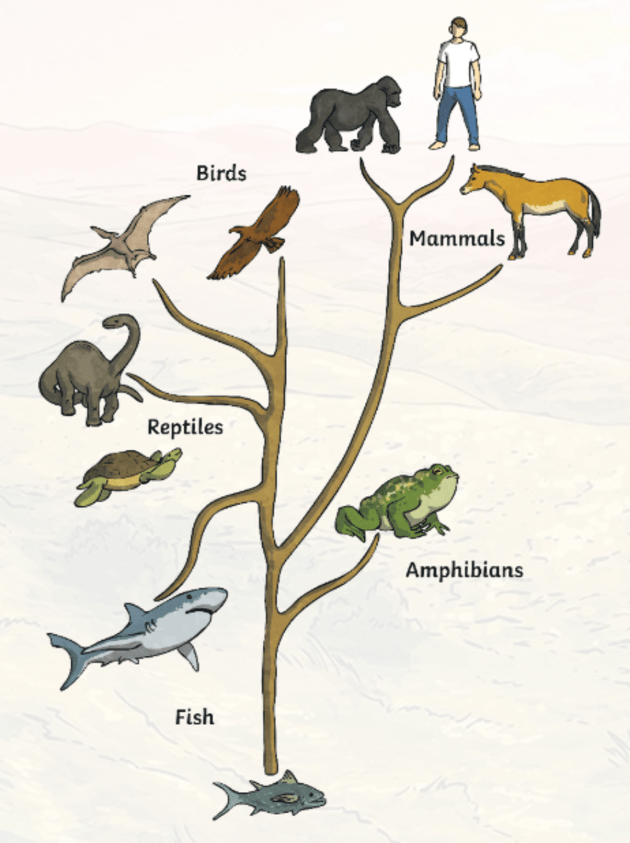
When we think of evolution, we often think of it as one straightforward process. However, there are a number of different types of evolution. Let’s have a look at some of these now:
First up is convergent evolution, which is when distantly-related organisms develop the same adaptations independently of one another, but amidst similar conditions, adapting to the same necessities.
Divergent evolution is the name given to the process by which a species interbreeds and splits off into two or more species.
Co-evolution is when two or more species of organisms evolve alongside one another, adapting to changes in each other. With this type of evolution, there is a relationship between the evolving organisms.
This type of evolution is when organisms are able to diversify, i.e., split into new forms, at a rapid rate. This occurs when certain changes in the environment around these organisms make new resources available to them, or new environmental challenges arise.
It is impossible to thoroughly discuss evolution without getting into genes. The human genome that we have today has been formed over time, through the process of evolution, undergoing many changes along the way.
Often, you will find DNA and genes in completely different species that look pretty similar. This is a great indicator that these species likely share common ancestors. Genes are extremely important, therefore, for providing insight into the evolutionary history of different species. For example, scientists have discovered that humans share a lot of their DNA with the fruit fly, Drosophila Melanogaster. These two species, which could not be more different in terms of their outward appearance, are very similar on a genetic level. In fact, through a great deal of study and research, it has been uncovered that human beings and the Drosophila Melanogaster fruit fly are a whopping 60% identical, genetically speaking. Most notably, scientists have found that humans and this fruit fly share 75% of the genes that cause disease in the human population.
DNA is constantly changing over time, with some of these changes benefitting the organism, and others having more negative effects. These beneficial changes can provide the organism with a selective advantage. However, on the flip side, the negative changes can harm or disrupt vital, everyday functions within the organism. For this reason, some genes do not change significantly over time but remain relatively constant.
The evolution of animals begins somewhere between 620 and 550 million years ago, during what was known as the Vendian Period. It was at this time that the very first animals appeared. These animals came in the form of fairly large, complex, soft-bodied multicellular creatures. Evidence of these animals was found in a number of different locations around the world, but they were first found in the Ediacara Hills of Southern Australia. This is why this group of animals is generally known as the Ediacaran fauna.
Whilst they are technically classified as animals, the Ediacaran animals are very different to the ones we know today. For instance, there is almost no evidence that the Ediacaran animals had a hard skeleton, meaning that they were completely soft-bodied organisms. Many of the Ediacaran animals have been compared to creatures like jellyfish and worms, and are believed to have had a sponge-like texture.
In terms of their looks, Ediacaran animals had a flat, quilted appearance, and ranged from around 1 cm to 1 m in size. Based on their shape, Ediacaran animals have been divided into 3 main groups: discoidal, frond-like, and ovate-elongate. Ediacaran animals were an extremely varied group of organisms. This information is important as it has led scientists to draw the conclusion that there must have been a long period of evolution prior to their first appearance in fossil records.
The Ediacaran animals completely disappear from fossil records around 544 million years ago, at the end of the Vendian Period. This is the first known mass extinction in the history of the evolution of animals.
Once the Ediacaran animals were gone, a range of animals that represented almost all of the modern phyla (phyla is a level of taxonomic ranking) took their place. These organisms that represented sponges, jellyfish, molluscs, insects, and more, appeared very suddenly in what is often referred to as the Cambrian explosion. The organisms appeared during the Cambrian period, hence the name of the event. Despite being described as abrupt, the appearance of these organisms is believed to have happened over a period of around 30 million years according to fossil records.
The reason why these organisms exploded onto the scene is a point of contention and debate amongst scientists. On one side of the argument, there are scientists that believe that the increase in oxygen levels in the atmosphere that began around 2000 million years ago is to blame. This increase in atmospheric oxygen supported a higher metabolic rate in organisms, thus allowing organisms to evolve that were larger and more complex in terms of structure.
It is also believed that the shift in ocean chemistry is likely to have contributed to the ‘explosion’ of new organisms. The changed chemistry of the ocean made way for a number of things. For instance, it allowed organisms to develop hard body parts like teeth.
Genetic factors also played a key role in the Cambrian explosion. Through extensive research, scientists have concluded that, during the period before the Cambrian explosion, a kind of ‘genetic tool kit’ of genes gradually developed. This tool kit had a huge impact on the developmental processes of organisms. Most notably, the tool kit gave way to a period of evolutionary experimentation and competition. The result of this was that a number of the organisms and forms that we see in the fossil records from this time are no longer around. After this period, the experimentation died down and evolutionary changes were restricted to working with the body plans that were currently in existence.
Another of the key changes that occurred during the Early Cambrian period was the development of animals that burrowed into the seafloor. Before these creatures, animals simply lay on top of the seafloor. The first carbonate reefs also developed during this time, which were actually constructed by a species of sponge-like animals known as archaeocyathids.
There have also been a number of scientific discussions going on recently about whether the Cambrian explosion was a real event or simply a reflection of the pattern of the fossil records.
Regardless of how the animals came into existence, it is believed that these animals may have actually stepped on land in the Early Cambrian period. This belief came about after a pair of animal footprints were discovered on sand dunes in 2002. These footprints belonged to creatures that would have scuttled across the dunes around 530 million years ago. Research has shown that the animals were arthropods, not dissimilar to modern-day centipedes. It is likely that these animals did not live exclusively on land, but instead just travelled there to mate or escape predators.
Before this discovery, it was widely believed that animals did not venture on land until the Silurian period, around 440 to 410 million years ago.
The idea that one type of organism could descend from another has been in existence for thousands of years, but the Theory of Evolution as we understand it today is largely due to the work of Charles Darwin.

In 1831, when Darwin was a young man of 22, he travelled to the Galápagos Islands aboard the HMS Beagle. While he was there, he started studying the local fauna, and in so doing started developing the Theory of Evolution.
Darwin noticed there were different types of finches on different parts of the islands. While the general consensus at the time was that these were birds of different species that happened to be similar to each other, Darwin theorised that these birds were related.
In one part of the Islands, bad weather had affected the local plants, causing only plants with large seeds to be available. Finches with larger beaks were able to break open those large seeds and eat them, while finches with smaller beaks couldn’t.
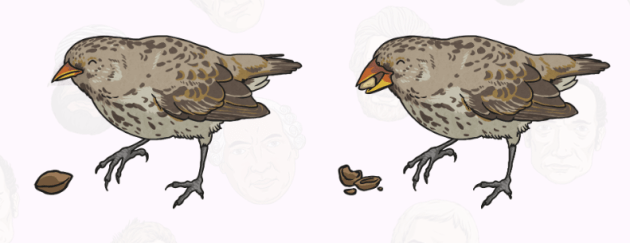
As a result, the finches with smaller beaks died and the finches with larger beaks reproduced until only finches with larger beaks existed in that part of the islands.
But, at the same time, in other parts of the islands, where the environment was markedly different, finches with smaller beaks were better able to feed off the local flora than finches with larger beaks, so the smaller-beaked finches were the ones that survived while the larger-beaked ones died out.
This is the basis behind Natural Selection, which is alternatively known as “Survival of the Fittest”. It is so named because only the organisms whose random mutations are most fitting for the surrounding environment will survive.
The image below shows how members of the same initial species of finch start to differentiate from each other as a result of different traits suiting different environments.
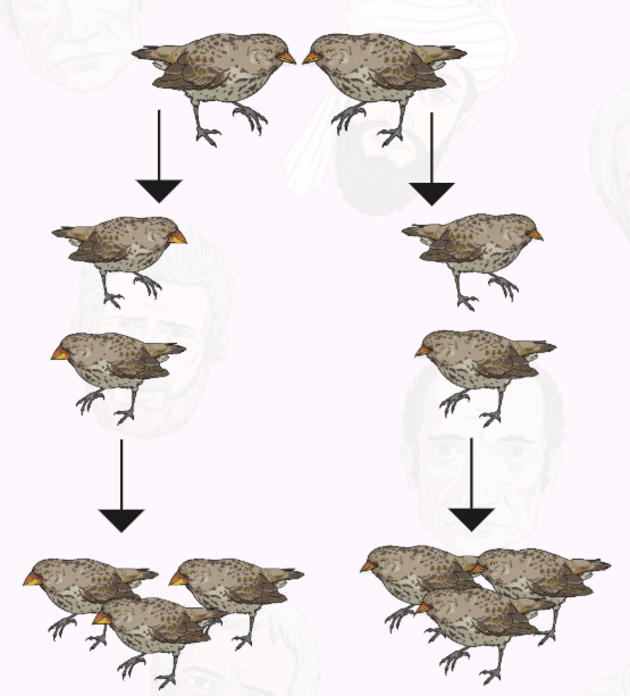
These separate groups of finches continued to adapt and change to suit their environment over many generations, until, eventually, they became different enough to become different species.
Darwin published his findings in 1859, in a book titled On the Origin of Species. Since then, both Darwin himself and different scientists who came after him have continued to work on the Theory of Evolution, tweaking it and perfecting it through scientific research and enquiry. Scientists who specialise in the Theory of Evolution are called evolutionary biologists.
It’s all well and good to say that animals have gradually changed over time, but it is impossible to say whether this is true unless there is some sort of proof.
The best proof we have for evolution comes in the form of fossils.
Fossils are the preserved remains of long-dead animals and plants and can take the form of skeletons, small shells, DNA remnants, animal tracks and footprints.
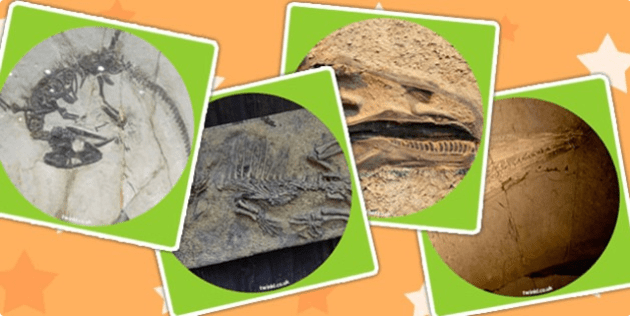
Usually, remains are considered fossils when they are over 10,000 years old, and some of the oldest fossils that have been found are over 4 billion years old. With such ancient remains in existence, it should be theoretically possible to see organisms go through several stages of evolution.
And, indeed, it is! Darwin used fossils as evidence to support the Theory of Evolution. The following picture shows how different fossilised skeletons can be compared to each other to show the evolutionary transition modern-day horses went through.
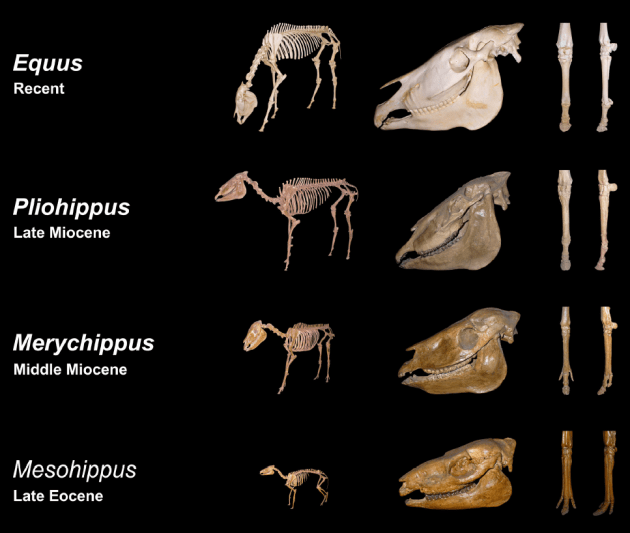
Unfortunately, it is often not possible to create perfect representations of the evolutionary transitions of a species. This is because fossils only happen when an organism dies in quite a specific environment, so there are plenty of different species throughout time that would have never been fossilised.
However, new fossils are being found all the time that help to ‘fill in the gaps’ and provide further evidence that evolution has taken place.
Evolution is a hugely important scientific theory for all children, and particularly children who have an interest in natural science, to learn about, for several reasons:
The following two images show how the forearms of dinosaurs evolved to become the wings of birds.


Known for their large, colourful beak and black feathers, toucans live in the tropical rainforest. Their beak can be up to half the length of their entire body and might at first seem like a liability to their evolution. Fortunately, toucans have developed several adaptations to support their life in the tropical rainforest. Here are just a few:
Toucan adaptations in the tropical rainforest help them find food much easier, look after their young and hide from predators. Some adaptations come about over many generations, with each generation mutating very slightly until there has been a big physical change. Other toucan adaptations in the tropical rainforest are social or behavioural and develop by watching other toucans.
Adaptation - How living things are specialised to suit their environment.
Biologist - A scientist who studies living organisms.
Evolution - The process by which the heritable traits of living things gradually change over time.
Hypothesis - A statement or proposed explanation that answers a certain question about something. It is based on limited evidence, as a starting point for further investigation.
Inheritance - The process of passing on features from parents to offspring.
Natural selection - The process by which organisms that are better adapted to their environment are more likely to survive and produce more offspring that carry their genetic characteristics.
Organism - A singular animal, plant, or single-celled life form.
Species - A group of living organisms with very similar characteristics, which are capable of breeding and exchanging genes.
Theory - An explanation for something that has not yet been proven as fact.
Variation - The differences between living things in a species.
A video like the one below is an excellent starter activity in a lesson that aims to explore the question “what does evolution mean?”. Aimed at children in primary school, it looks at how animals have evolved over millions of years!